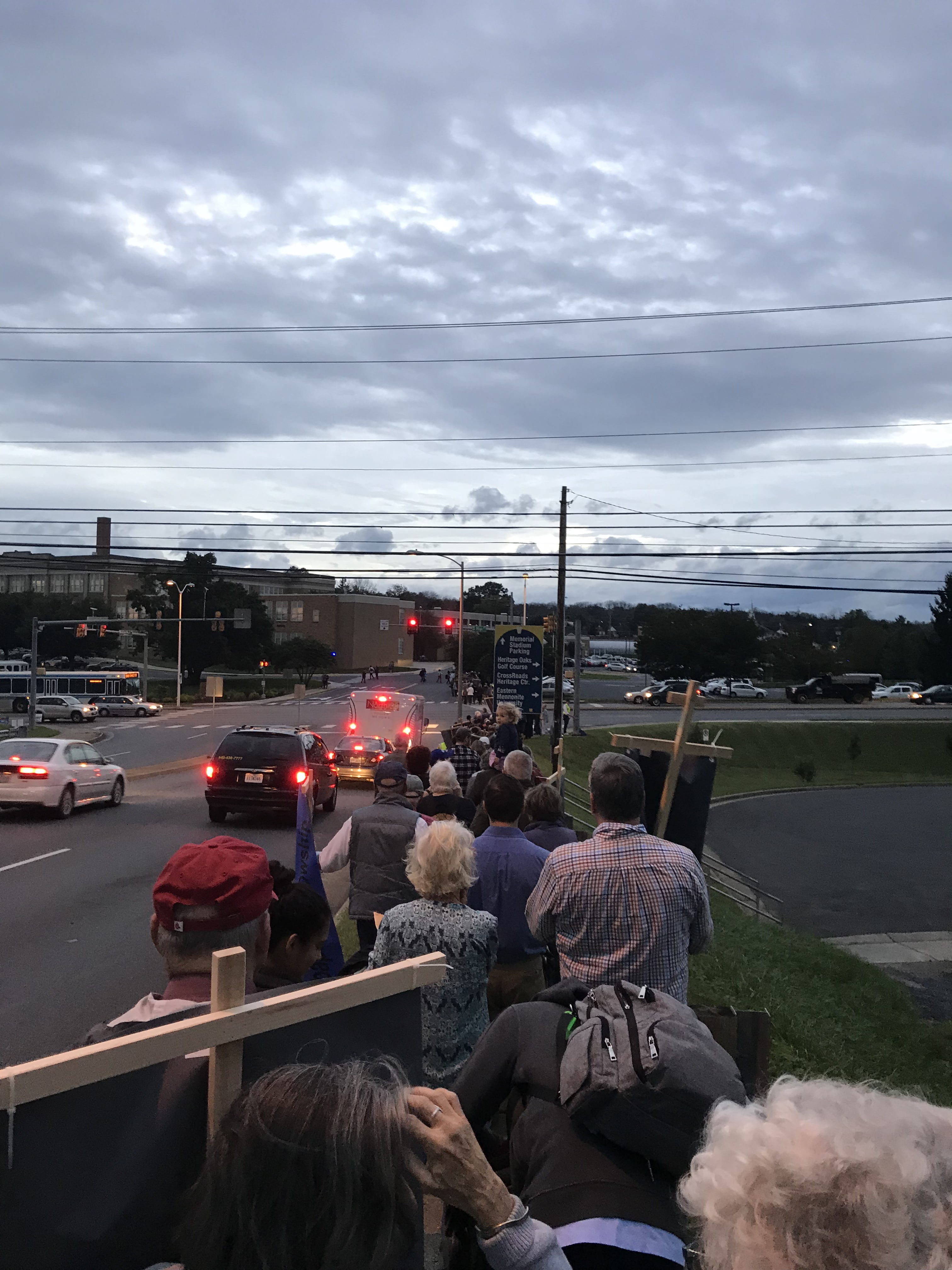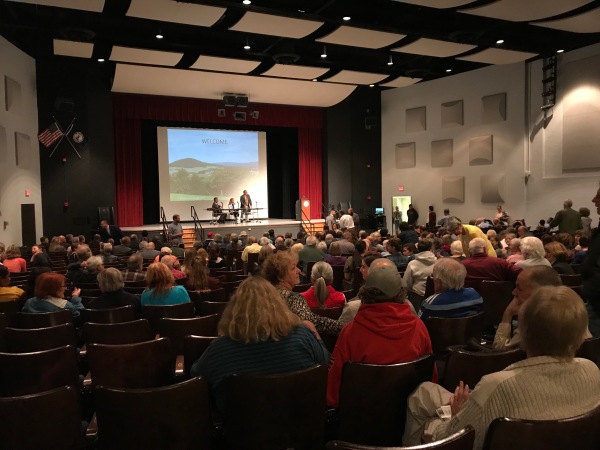 Post by Shelby Taraba, Madison Center JMU Engagement Fellow, ’18-’19
Post by Shelby Taraba, Madison Center JMU Engagement Fellow, ’18-’19
On Monday October 15th, Faith in Action gathered at the corner of E. Market Street and High Street in preparation for their march to Memorial Hall for the Criminal Community Justice Board Meeting to show the city of Harrisonburg their dedication as an organization to the three asks of their campaign. Faith in Action is a coalition of congregations working together to affect systemic change in the Harrisonburg-Rockingham community. Every year, Faith in Action committees vote to take on a new campaign for change in the community that is in accordance with their guiding values. This year they are committed to work with relevant policy makers and stakeholders to:
- Eliminate the financial burden of the $1 per day fee currently paid by families of inmates at our local jail and the $3 charge for local inmates transferred to the Middle River Regional Jail.
- Engage in careful and open selection process for the hiring of a well-qualified Community Justice Planner.
- Establish protocols for all juvenile justice cases to be screened for a restorative justice process.
Marching from High Street, down E. Market St, and a right on Liberty the estimated hundred-strong group of peaceful marchers stopped in front of the jail for a prayer and to wave to the incarcerated individuals knocking on their windows and waving. Just to serve as a reminder that we were marching for those who could not.
The march concluded at Memorial Hall and a couple hundred community members gathered outside eager to go in and find their seats for the Criminal Community Justice Board Meeting.
 To begin the meeting, a member of the board introduced the two guest speakers, Kathy Rowings, a Justice Program Manager, and Neal Goodloe a Criminal Justice Planner. The board highlighted the ways in which Harrisonburg/Rockingham County is already engaged in criminal justice reform, including:
To begin the meeting, a member of the board introduced the two guest speakers, Kathy Rowings, a Justice Program Manager, and Neal Goodloe a Criminal Justice Planner. The board highlighted the ways in which Harrisonburg/Rockingham County is already engaged in criminal justice reform, including:
- Crisis Intervention Team and Training Program
- Mental Health pod in jails
- Mobile Crisis Response Team
- On-call Crisis Intervention
- Pretrial Services
- An Ongoing discussions of the implementation of a Criminal Justice Planner or Coordinator.
Kathy Rowings began her discussion of research-based decision making, where solutions are implemented in accordance with the factually based information provided by NACo, the National Association of Counties. NACo provides advocacy, research, training, and peer networks to prioritize:
- The Effective Use of Jails
- Stepping up Initiative
- Pretrial Justice Reform
- Data-Driven Justice
Kathy highlighted two major national concerns for criminal justice reform: incarcerated individuals pretrial, and incarcerated individuals experiencing mental illness. She informed the audience that two-thirds to three-fourths of county jail populations are pretrial, three-fourths of pretrial individuals are in jail for drug, property, or other nonviolent offenses, and 90% remain in jail because they cannot pay their bonds. Many cannot even pay what is considered a low bail of a few hundred dollars. To reform the issue of individuals in jail pretrial, Kathy recommended pre-arrest diversion training (CIT/LEAD) , implementation of risk and needs assessments, as well as supervision strategies and services, pointing to Caldwell Texas as a successful example of pretrial justice in practice. Caldwell implemented supervision services where a pretrial officer reviews the jail roster daily to identify inmates who have been unable to post bond and then screens the individuals to determine eligibility for pretrial release.
On the topic of mental illness, Rowings detailed that in society only 5% of individuals experience severe mental illness compared to the 17% of incarcerated individuals who experience severe mental illness and the 72% who experience co-occuring substance abuse disorder. In effort to combat the issue of mental illness in jails, Rowings offered four key measures:
- Reducing number of people with mental illness booked into jails through crisis diversion centers that could function as safe spaces for those experiencing difficulties with mental illness.
- Reducing lengths of sentences through bail policy reform, correctional officer training, pretrial risk screenings, release, and supervisions.
- Reducing recidivism through risk-need responses, evidence based practices, and specialized probation.
- Increasing access to treatment through healthcare, peer support programs, community based treatment, and housing.
Neal Goodloe provided facts and figures for the nine counties in Virginia that he represents as the Criminal Justice Planner pertaining to costs, crime trends, and reentry populations. He presented evidence on the following:
- Jails are expensive
- General population size is growing slower than the exploding populations in jails.
- Crime has dropped nationally since 1991.
- Property crimes are going down.
- Total bookings per year are very high.
- Violation of court order is the highest percentage of charge type.
- Small portions of the jail population are what increase expense cost of jails.
- Only 16% of total bookings are violent felonies, violent misdemeanors, sex offenses, weapons, compared to 84% of total bookings that comprise nonviolent offenses.
- 51% of the inmate population is LOW-risk while only 18% are considered high-risk.
- There is an unbelievably high number of low-risk elderly population in jails.
- Probation violations comprise the highest/longest sentences.
- 71/9044 (.7%) of Incarcerated individuals drove 5.7% of bed expenditures and 17.1% of booking volume.

Recent Comments